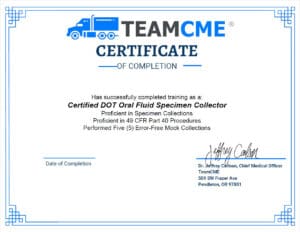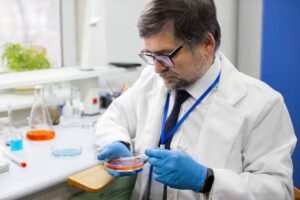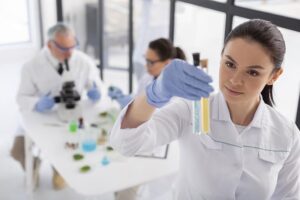DOT Oral Fluid Collection Training and Certification
Provide DOT and non-DOT drug testing by becoming a certified DOT oral fluid (saliva) specimen collector.
Registration will be available upon DOT’s approval of testing devices
- This course includes both the qualification training and the proficiency demonstration (mock collections).
- 5 mock collections are required per device. (If you are being trained to perform collections using 2 different devices from 2 different manufacturers, a total of 10 mock collections are required.) There is an additional fee of $150 for multiple devices.
Contact us about clinic and group registrations
The Department of Health and Human Services (HHS) has not yet approved devices or certified labs that may be used for oral fluid drug testing.
The Department of Transportation (DOT) stipulates that the proficiency demonstration (mock collections) must be completed within 30 days of the qualification training. However, mock collections cannot take place until the DOT has approved testing devices. TeamCME believes it is not in the best interest of our customers to have them complete the qualification portion before device and lab approvals are finalized. Otherwise, students may need to retake the qualification portion if they have waited longer than 30 days.

Qualification Training
2 training videos provide an in-depth discussion of everything a specimen collector should know

Proficiency Demonstration
5 mock collections performed via video conference

Training Manual
A downloadable PDF version of the training manual

Training Certificate
Available upon review of your completed CCFs from the mock collections

Chain of Custody Forms (CCF)
CCF completion instructions and samples of completed CCFs

Collection Checklist
Step-by-step instructions, walking you through the entire process

Scripted Statements
Don’t sweat the mock collections! Simply follow this script

Flowcharts & Brochures
Helpful information to provide to the donor when needed
What you’ll learn
Master the essential skills and knowledge required to become a certified DOT urine specimen collector, including:
- Proper specimen collection procedures
- Maintaining the integrity of the specimen
- How to properly complete a chain of custody (CCF)
- Legal and ethical considerations
- DOT-mandated protocols
- How to handle challenging collection scenarios
Curriculum
There are 2 video modules in this course, 1 quiz, and a proficiency demonstration (mock collections)
Video Module One – 19 minutes
Introduction to Certification
- Purpose of Training
- Reference to the DOT Oral Fluid Specimen Collection Procedures Guidelines
- Importance of Safety and Drug-Free Workplace Policies
Overview of DOT Drug Testing Procedures
- DOT’s “Gold Standard” for Drug Testing
- Applicable Parties:
- Employers under DOT regulations
- Urine and Oral Fluid Specimen Collectors
- Various DOT Administrations (FAA, FMCSA, FRA, FTA, PHMSA, USCG)
- Specificity of Procedures and Compliance
Role and Responsibilities of the Collector
- Key Responsibilities
- Collector’s Influence on Test Credibility
- Definition of a Collector
Guidelines for Federal Workplace Oral Fluid Drug Testing
- Who Can Perform a Collection?
- Who Cannot Perform a Collection?
Collector’s Responsibilities
- Identification Requirements
- Documentation and Compliance with DOT Representatives
- Communication with Designated Employee Representatives (DERs) and Service Agents (SAs)
- Knowledge of Employer’s Standing Orders
- Proper Handling of Different Specimen Types (Urine vs. Oral Fluid)
Designated Employer Representative (DER)
- Oversees Drug and Alcohol Testing Programs
- Receives and Communicates Results
- Removes Employees from Safety-Sensitive Duties if Needed
Collector Training Requirements
- Qualification Training:
- Training on Procedures, Devices, and CCF Completion
- Handling “Problem” Collections
- Recognizing and Correcting Fatal Flaws
- Proficiency Demonstration:
- 5 Consecutive Error-Free Mock Collections
- Scenarios: Insufficient Specimen, Tampering, Refusal to Sign, etc.
- Recertification & Error Correction Training:
- Required every 5 years
- Error Correction Training for Fatal Flaws
- Mock Collections for Retraining
Reasons for Drug Testing
- Pre-Employment
- Post-Accident
- Random Testing
- Reasonable Suspicion
- Return-to-Duty & Follow-Up Testing
Collection Sites
- Locations
- Emergency Collection Sites (if regular site unavailable)
- Site Requirements
Ensuring Integrity & Security in Oral Fluid Collection
- Restricting unauthorized access
- Maintaining specimen privacy and security
- Avoiding distractions and interference
- Continuous supervision during the collection process
- Authorized personnel allowed in collection areas
Role of the Medical Review Officer (MRO)
- Responsibilities
- Communication Process with Donors
Identification Requirements for Testing
- Acceptable Forms of ID
- Unacceptable Forms of ID
Federal Drug Testing Custody and Control Form (CCF)
- Purpose and Importance
- CCF Documentation Process:
- Five-Part Form Distribution (Lab, MRO, Collector, Employer, Employee)
- Proper Entry Guidelines (Ink, Specimen ID Verification, Oral Fluid Box Marking)
Video Module Two – 35 minutes
Preliminary Collection Steps
- Handling donor no-shows or late arrivals
- Explanation of basic collection procedures to the donor
- Using the electronic CCF
- Starting the collection without delay
Donor Identification & Security Procedures
- Removal of outer clothing & personal belongings:
- Pocket check for prohibited items
- Handling medications brought to the collection site
Oral Cavity Inspection & Initial Collection Steps
- Handling dry mouth or abnormal saliva color:
- If donor refuses to rinse mouth, report as a refusal to test
- Multiple tests in one session
Completing the CCF (Custody & Control Form)
- Step 1 (Copy 1) – Initial Data Entry
- Step 2 (Copy 1) – Collector Notes
- Step 4 (Copy 1) – Expiration Date of device
Specimen Collection Process
- Hand sanitization prior to specimen collection
- Collector’s presence is mandatory throughout the collection
- If donor claims they cannot provide a specimen
- Verifying specimen volume
Handling Potential Tampering or Adulteration
- Signs of tampering
- Actions if tampering is suspected
- If donor refuses
Completing the Collection Process
- Step 5 (Copy 2) – Donor Certification
- Finalizing the CCF
- Distribution of CCF Copies
Insufficient Specimen Handling & Refusal to Test
- If donor cannot produce a sufficient sample
- If still insufficient after second attempt
- Criteria causing a refusal to test
Handling Collection Errors & Correctable Flaws
- Correctable Flaws
- Fatal Flaws (cause test cancellation)
Employer’s Choice in Specimen Type
- Employers may choose urine or oral fluid testing for different situations
- Employers should have a written protocol on when oral fluid vs. urine is used
- Switching from Oral Fluid to Urine Collection
Specimen Collector Quiz – 30 questions
Student must achieve an 80% or above. It can be taken as many times as needed.
Proficiency Demonstration ( 5 Mock Collections) – 90 minutes per device per manufacturer
This section is accessible upon completion of the quiz. It is performed via live video conference. Students can schedule a time through our online scheduling platform located within the proficiency lesson.
Articles

Starting Your Own DOT Drug Testing Business
Blog Article
Frequently Asked Questions
What is oral fluid drug testing?
Oral fluid testing is taking a sample of an individual’s saliva and submitting the sample to a lab where it is tested for certian types of drugs.
Who can become a certified DOT oral fluid specimen collector?
To qualify for training as a certified specimen collector for DOT drug testing, you must first meet the minimum qualifications set by the Department of Transportation:
- You need to be at least 21 years of age
- Have a high school diploma or equivalent
- Have a clean criminal record
- Be able to communicate and understand instructions in English
What are the benefits of oral fluid drug testing vs urine testing?
To qualify for training as a certified specimen collector for DOT drug testing, you must first meet the minimum qualifications set by the Department of Transportation:
- Reduced collection time
- Specimen can be conveniently collected on-location.
- No need for a separate restroom/collection facility
- Minimal chance of specimen adulteration
- Specimen collection is always directly and easily observed.
- No gender-specific staff needed
- Additional oral fluid specimens can be provided immediately
Why should you enroll in DOT oral fluid collector training?
DOT oral fluid testing is convenient and reliable. It is rapidly becoming a preferred method for drug testing.
What are the steps to take when becoming a certified DOT oral fluid specimen collector?
Enroll in an accredited DOT oral fluid specimen collector certification course
Once enrolled:
- Familiarize yourself with the regulatory language from the DOT 49 CFR Part 40.
- Review the DOT agency regulations and oral fluid specimen collection guidelines, so you can easily follow them in training
- Complete the certified urine specimen collector training course
- Demonstrate your proficiency in collections
- Obtain your training certificate
What Drugs Are Screened for in an Oral Fluid Drug Test?
The most common panels available are a 5-panel, 7 panel and 9-panel oral fluid drug test. However, there are several options when testing oral fluid.
How accurate is oral fluid drug testing?
Oral fluid is tested at a much lower screening level than urine. Laboratories perform an enzyme-linked immunosorbent assay (ELISA). This screening method provides adequate sensitivity to detect drugs of abuse. If the screening method is positive for a drug, the oral fluid specimen receives a confirmation test using mass spectrometry.
How long does it take to get results?
Negative results are usually received within 24 hours from the time the specimen arrives at the laboratory. When a confirmation test is needed due to a positive screening test, the results are usually available after an additional 72 hours.
what are the benefits of oral fluid drug testing for DOT-regulated companies?
Employers are able to choose between either an oral fluid collection or DOT urine collection for any DOT-regulated drug test. Saliva testing is becoming a popular option because unlike a urine test, it is non-invasive. An oral fluid collection is also less susceptible to a specimen being adulterated as it is always a directly observed collection.
When do businesses require drug tests?
Businesses can require a drug test under the following conditions:
- Onboarding: Some businesses want assurances right off that a new hire isn’t using. They can require testing as part of the hiring process.
- Randomized: Some businesses employ a randomized drug testing protocol. It makes drug testing less predictable and encourages operators to stay clean.
- Post-Accident: Anytime there is an accident, DOT operators are required to do a drug and alcohol test to prove they were sober at the time of the incident.
- Reasonable Suspicion: If an employee is acting out of character, slurring their speech, smells of alcohol or marijuana, or gives their boss reasonable cause to suspect the employee is using on or before the job, the employer can require a drug test.
- Return to Duty: If an employee fails a drug test and goes through the substance abuse program, they must pass the drug and alcohol test before they can return to work.
- Follow-up: After a return to duty test, several follow-up tests will prove the employee is maintaining their sobriety.
What are the certification renewal requirements for DOT drug testing?
You must also undergo refresher training every five years to maintain your DOT specimen collection certification. The renewal training and the initial training are generally the same training.
However, the DOT expects you to stay current with regulations and collection procedure changes between your courses instead of waiting for your refresher course.
How long is oral fluid drug testing certification good for?
Certified DOT oral fluid collectors are certified for 5 years from the original certification date. To remain certified, an individual must retake a certification course.
What kind of documentation must I keep to show that I’m qualified?
Your training organization should provide you with a certificate. When requested, collectors must provide documentation to DOT Agency inspectors, employers, and employer-designated service agents who may contract for their services that they are currently eligible to collect DOT specimens.
On request, you must provide sufficient detail on the content of the training and proficiency demonstration so that the Federal Inspector can be confident that you fully met the requirements of the regulation.
What is included in the oral fluid drug testing certification training?
This training program consists of 2 video modules, 1 quiz, and a proficiency demonstration (mock collections).
Training Includes:
- Downloadable training manual
- Chain of Custody Forms (CCFs)
- Collection checklist
- Scripted statements
- Flowcharts
Upon completion, the student can download and print a certificate of completion, certifying them as a DOT Oral Fluid Specimen Collector.
How long is the specimen collector training course?
There are 2 video modules equaling approximately 89 minutes. The course also contains a 32-question specimen collector quiz. Finally, the proficiency demonstration (mock collections) takes roughly 90 minutes to complete.
Can I stop and start the training as needed?
Yes. The course and all its content is available at any time. When you pause your training, the course will keep track of where you left off. Even after completion, you can go back and review the material.
Can I review the training material multiple times?
Yes. Your training is valid for one year. All of the material including video modules and documents can be reviewed as much as needed.
When will I get my training certificate?
Your training certificate will be available to download once we receive the completed CCFs from the mock collections. It can be found in your training portal.
What are the differences between DOT and non-DOT drug tests?
DOT Tests are Regulated and More Comprehensive
- DOT drug tests are regulated by the US Department of Transportation
- DOT drug tests test for a wider range of drugs, including amphetamines, marijuana, cocaine, and opiates, while non-DOT drug tests usually only test for marijuana, cocaine, and opiates
- DOT drug tests are more expensive than non-DOT drug tests
Where can I get more information on the collection regulations and guidelines for collectors?
You can visit the Office of Drug & Alcohol Policy & Compliance (ODAPC) website at www.transportation.gov/odapc. On the home page you can select the link to the ‘Oral Fluid Collectors’ page.
Are you receiving training for a single manufacturer or multiple manufacturers?



